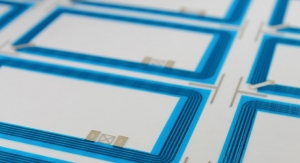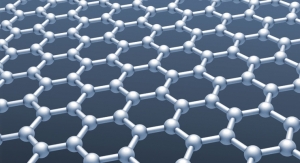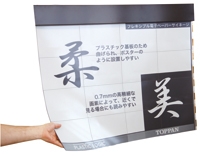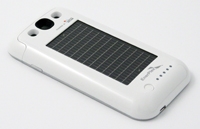David Savastano, Editor09.04.13
Graphene has become a material of great interest to many industries, including printed electronics. A one-atom thick layer of graphite that is formed in a hexagonal lattice, graphene offers superior performance properties, including excellent conductivity and electron mobility, high opacity, flexibility and tremendous strength, equal to 100 times the strength of steel at the same thickness. As a result, graphene could have a role to play in integrated circuity, transistors and printed electronics.
Naturally, graphene is of great interest to researchers and universities alike. The University of Cambridge has been studying graphene since 2003, and recently opened the Cambridge Graphene Centre (CGC). The CGC will be led by Andrea Ferrari, professor of nanotechnology and Royal Society Wolfson Research Merit Award Holder.
In addition, Prof. Ferrari is the head of the Nanomaterials and Spectroscopy Group at the University of Cambridge Engineering Department and Nanoscience Centre, and is professorial fellow of Pembroke College.
Cambridge has received significant financial backing for the CGC. The Centre has received a grant of £12 million from the UK government via the Engineering and Physical Sciences Research Council (EPSRC) in December 2012. The Centre has gathered £13 million in-kind and direct support from more than 20 corporate partners, and an additional £11 million from the European Research Council funding will support activities with Lancaster University and the Graphene Institute in Manchester.
Prof. Ferrari noted that in addition to this funding, the University of Cambridge decided to invest £13 million to construct a new building, which will be ready in 2015.
“We are already up and running in a variety of locations, but when we move into a single location, that will offer is maximum advantages,” Prof. Ferrari said. “We are hiring at the moment, and already have 40 people here, as well as a lot of associate members.”
Prof. Ferrari noted that the support from industrial partners has been substantial. For example, Plastic Logic has donated large scale deposition equipment to the Centre to support acceleration of manufacturing scale-up.
“Industry support has come in different forms, whether it is personnel, donating small or large pieces of equipment, cash and advice,” he reported. “We have a lot of interest form companies, and are working on IP agreements.”
Prof. Ferrari has been studying carbon materials for more than 15 years, including work on carbon nanotubes, while the University of Cambridge has developed world-leading expertise in carbon materials for more than 30 years.
“My first paper on graphene came out in 2004,” he said. “It is a very unique material for a variety of reasons. It is the strongest, most flexible material, and it interacts with every wavelength of light. It is ideal for composites and biological materials. Graphene offers much better performance than most technologies, and it is the first of a very long list of 2-D materials that can be exfoliated to a single layer.”
Those enhanced performance characteristics, like improved mobility, have translated to lab-scale improvements.
“Graphene can be used to make functional inks,” Prof. Ferrari noted. “It can be transparent and it is highly conductive, which leads to flexible, bendable transistors. In printed electronics, one problem is that the mobility of carriers is very small. The first time we printed a device, we got 10 times better mobility than the state-of-the-art in organic printed electronics.”
Graphene offers numerous advantages, but there still is much work to be done before it becomes a commercial success.
“The big challenge is to show that graphene isn’t only good at the lab scale,” Prof. Ferrari said. “That has been proven daily. The challenge is to produce it in large scale, and we hope to do that in the next 10 years for fields such as consumer electronics.
“Another big challenge is to bring graphene from the lab to the marketplace,” he added. “We can produce graphene, but we need to match materials to graphene. For example, chemical vapor deposition, which reaches temperatures of 1,000°F cannot be directly used on plastic. For this reason, we have a huge focus on inks based on graphene related materials and hybrids that can be deposited at room temperature.”
Prof. Ferrari said that the CGC is already working with companies to determine near-term technologies.
“There is a lot of interest,” he said. “For example, we are working with Plastic Logic on flexible displays, and Novalia uses grapheme on their drum kit poster. Graphene is already used in products from tennis racquets to security tags. I think the imagination is the limit for graphene, and the challenge is to translate what we do in the lab to production.
“The road from the lab to the market is very long, and there comes a point where the science is done and companies have to market it,” Prof. Ferrari concluded. “There are so many possibilities for transparent conductors. It is a very interesting material. It is a platform material, and can be applied to almost any field. We are at a time of great opportunities, and I think in five years, we will be able to assess where graphene is heading, and if it has indeed lived up to expectations.”
Naturally, graphene is of great interest to researchers and universities alike. The University of Cambridge has been studying graphene since 2003, and recently opened the Cambridge Graphene Centre (CGC). The CGC will be led by Andrea Ferrari, professor of nanotechnology and Royal Society Wolfson Research Merit Award Holder.
In addition, Prof. Ferrari is the head of the Nanomaterials and Spectroscopy Group at the University of Cambridge Engineering Department and Nanoscience Centre, and is professorial fellow of Pembroke College.
Cambridge has received significant financial backing for the CGC. The Centre has received a grant of £12 million from the UK government via the Engineering and Physical Sciences Research Council (EPSRC) in December 2012. The Centre has gathered £13 million in-kind and direct support from more than 20 corporate partners, and an additional £11 million from the European Research Council funding will support activities with Lancaster University and the Graphene Institute in Manchester.
Prof. Ferrari noted that in addition to this funding, the University of Cambridge decided to invest £13 million to construct a new building, which will be ready in 2015.
“We are already up and running in a variety of locations, but when we move into a single location, that will offer is maximum advantages,” Prof. Ferrari said. “We are hiring at the moment, and already have 40 people here, as well as a lot of associate members.”
Prof. Ferrari noted that the support from industrial partners has been substantial. For example, Plastic Logic has donated large scale deposition equipment to the Centre to support acceleration of manufacturing scale-up.
“Industry support has come in different forms, whether it is personnel, donating small or large pieces of equipment, cash and advice,” he reported. “We have a lot of interest form companies, and are working on IP agreements.”
Prof. Ferrari has been studying carbon materials for more than 15 years, including work on carbon nanotubes, while the University of Cambridge has developed world-leading expertise in carbon materials for more than 30 years.
“My first paper on graphene came out in 2004,” he said. “It is a very unique material for a variety of reasons. It is the strongest, most flexible material, and it interacts with every wavelength of light. It is ideal for composites and biological materials. Graphene offers much better performance than most technologies, and it is the first of a very long list of 2-D materials that can be exfoliated to a single layer.”
Those enhanced performance characteristics, like improved mobility, have translated to lab-scale improvements.
“Graphene can be used to make functional inks,” Prof. Ferrari noted. “It can be transparent and it is highly conductive, which leads to flexible, bendable transistors. In printed electronics, one problem is that the mobility of carriers is very small. The first time we printed a device, we got 10 times better mobility than the state-of-the-art in organic printed electronics.”
Graphene offers numerous advantages, but there still is much work to be done before it becomes a commercial success.
“The big challenge is to show that graphene isn’t only good at the lab scale,” Prof. Ferrari said. “That has been proven daily. The challenge is to produce it in large scale, and we hope to do that in the next 10 years for fields such as consumer electronics.
“Another big challenge is to bring graphene from the lab to the marketplace,” he added. “We can produce graphene, but we need to match materials to graphene. For example, chemical vapor deposition, which reaches temperatures of 1,000°F cannot be directly used on plastic. For this reason, we have a huge focus on inks based on graphene related materials and hybrids that can be deposited at room temperature.”
Prof. Ferrari said that the CGC is already working with companies to determine near-term technologies.
“There is a lot of interest,” he said. “For example, we are working with Plastic Logic on flexible displays, and Novalia uses grapheme on their drum kit poster. Graphene is already used in products from tennis racquets to security tags. I think the imagination is the limit for graphene, and the challenge is to translate what we do in the lab to production.
“The road from the lab to the market is very long, and there comes a point where the science is done and companies have to market it,” Prof. Ferrari concluded. “There are so many possibilities for transparent conductors. It is a very interesting material. It is a platform material, and can be applied to almost any field. We are at a time of great opportunities, and I think in five years, we will be able to assess where graphene is heading, and if it has indeed lived up to expectations.”

















